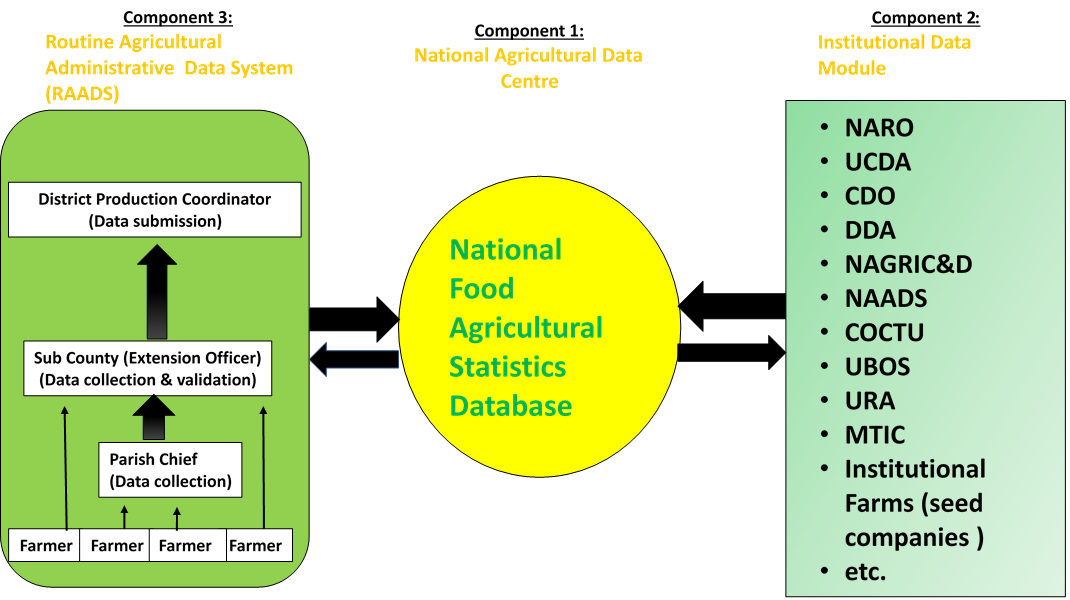To spearhead the production, dissemination and use of quality Agricultural Statistics for efficient and effective management of the Agro-Industrialization programme
 Core Functions
Core Functions
1. Collection, analysis and dissemination of quality Agro-Industrialization programme administrative data
2. Designing and implementation of agricultural surveys and Censuses
3. Implementation of the Agricultural sector strategic plan for Statistics in line with the Plan for National Statistics Development
4. Develop and maintain a comprehensive Agro-Industrialization Programme database (NFASS)
5. Liaise with Uganda Bureau of Statistics (UBOS) to retrieve and analyze survey and census data
6. Provision of agricultural Statistics to users
- Gender responsiveness
- Sustainability
- User satisfaction
- Confidentiality
- Quality
- Team work
- Professionalism
- Transparency and accountability
- Efficiency
Goal
To ensure that data related to the Agricultural Sector is accurate, timely, consistent, disaggregated and accessible so as to facilitate planning, and decision making in MAAIF, Agencies and Local Governments
Objectives
- Harmonize data collection protocols across MDAs, LGS and institutional partners
- Establish a permanent field data collection system
- Utilize the data collected optimally so as to reduce the cost of data collection
- Increase the dissemination and utilization of the statistics generated
- To enable the quick flow of reliable information amongst all stakeholders
Components
- National Agricultural Data Centre
- Institutional Data Module (Agricultural Data linkage & Coordination Protocols within MDA’s)
- Routine Agricultural Administrative Data Reporting Systems (RAADRS)
Details about the components
National Agricultural Data Centre
Establish a Data Center that will enable MAAIF become a central resource for quality and timely agricultural information.
- Establishment of an integrated database, learning laboratory, and agricultural library
- Establish within the Data Centre an on-the-job training/learning capability
- Facilitate digital linkages to data sources
- Enable GIS capacity
- Provide ease of file transfer with lower costs and time to acquire data/information
Institutional Data Module (Agricultural Data linkage & Coordination Protocols within MDA’s)
Increase the flow of quality data and information amongst the various institutions (MDAs) involved in some form with agricultural development in Uganda.
- Enable the Agricultural Planning Department to become a central resource for quality agricultural information.
- Establish clear communication linkages between MDAs and the Data Centre
- Establish data and information transfer protocols to ensure the maximum flow of data between the institutions and the Data Center
Routine Agricultural Administrative Data Reporting Systems (RAADRS)
Establish a cost-effective routine (on-going) data collection network that can deliver quality data from all districts and sub-counties
- Train all relevant officers in data collection and management procedures
- Establish an efficient and cost effective “sentinel farmer” system for routine data collection
- Establish data collection, data flow, quality control, and distribution procedures

To ensure that data related to the Agricultural Sector is accurate, timely, consistent, disaggregated and accessible so as to facilitate planning, and decision making in MAAIF, Agencies and Local Governments
- Harmonize data collection protocols across MDAs, LGS and institutional partners
- Establish a permanent field data collection system
- Utilize the data collected optimally so as to reduce the cost of data collection
- Increase the dissemination and utilization of the statistics generated
- To enable the quick flow of reliable information amongst all stakeholders